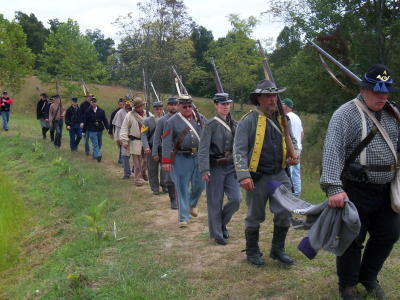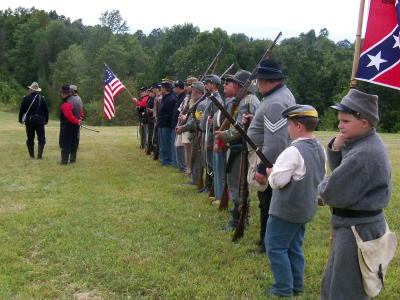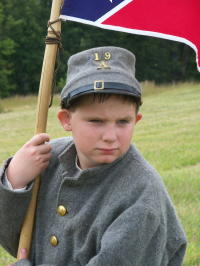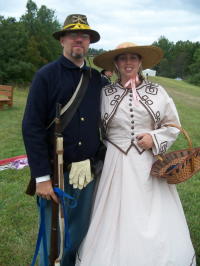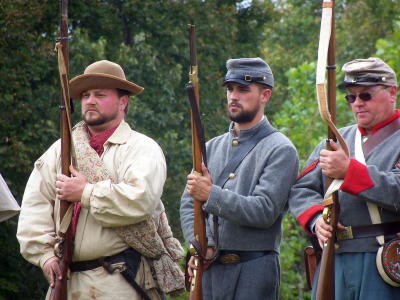HISTORICAL ACCOUNT: THE BATTLE OF SYCAMORE - Civil War Reenactment Photos
The Battle of Sycamore, staged for Calhoun Days by regional Civil War reenactors was based on a real-life skirmish that happened in an area not far from the Calhoun County Park, where the drama was staged.
The historical account of the battle was written by former Calhouner and famous West Virginia historian Boyd Stutler, and published in "Calhoun County in the Civil War."
Stutler's account is published here, with photos of the 2010 reenactment inserted. - Bob Weaver
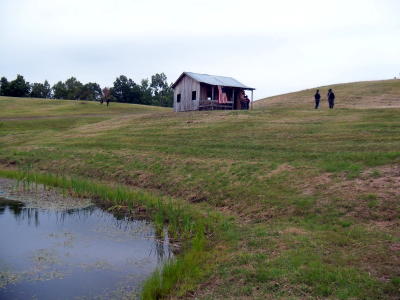
The battle starts after a quiet dinner
at the McDonald cabin on Sycamore ...
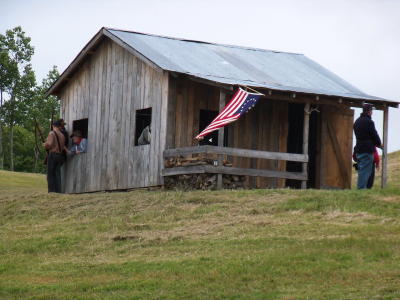
... with shots fired at the cabin, the situation quickly escalates ...
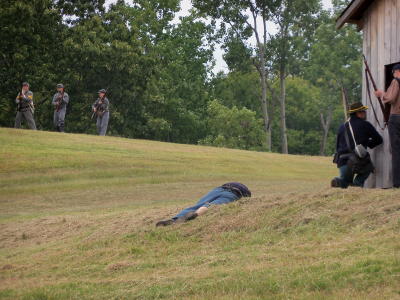
... with the soldiers moving into the woods
and fields, some of them dying in the affray ...
PARTISAN RANGERS AND UNION
RECRUITS SKIRMISH IN CALHOUN
By Boyd B. Stutler, "Calhoun County in the Civil War"
To be sure, as battles of the Civil War are measured by later generations, the action on the ridge at the forks of Sycamore Creek, Calhoun County, at high noon on November 28, 1861, was a very minor affair.
So minor that it did not get mentioned in the roll of 632 actions listed under sixteen categories occurring in West Virginia during the four-year period, and would have been entirely forgotten had it not been that a volunteer reporter for the Wheeling Intelligencer wrote a highly colored, and somewhat inaccurate, story of the encounter.
Then, too, there was the mellowed memories of veterans who had participated in the action who told their stories in later years, to which this narrative is indebted.
The action was an exchange of gunfire lasting about forty-five minutes between Captain Perry Conley's band of irregular Southern partisans, a splinter group of the Moccasin Rangers, and a detachment of Captain James L. Simpson's Company C, Eleventh (West) Virginia Infantry, which had not yet been mustered into Federal volunteer service.
It was probably the first time members of Company C had come under enemy fire.
The rest of the engagement was indecisive as both combatants cleared out of the scene of action as quickly as possible, Conley's rangers withdrawing first to get out of musket range.
The number of casualties suffered by the combatants remains undetermined, the reports ranging from a loss by Conley of six dead and a number wounded, as reported by the Intelligencer correspondent, to one Union soldier wounded and one known ranger killed, as recalled by participants.
Though Calhoun County was almost equally divided in allegiance to the government at Washington and to Virginia, the Southern dissidents seized the military initiative early in the spring of 1861.
Bands of irregulars operating under self-appointed captains, generally known as Moccasin Rangers, were organized and soon spread terror to the element holding true to the old flag.
Of these semi-independent groups none was more active than the one captained by Perry Conley, who had promised General Henry A. Wise one hundred Yankee buttons for a good rifle.
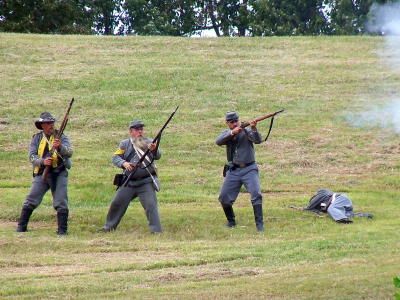
The 45-minute skirmish turns bloody
In the fall of 1861, Captain James L. Simpson, of Parkersburg, set about recruiting a company in Calhoun County for a new loyal regiment, but he found the recruiting a slow process in that disturbed area where Union men feared to leave their homes and families unprotected.
Within a few weeks, Simpson did get enough men together to make up the major part of a company and led them to Camp Pierpont near Elizabeth, where a Wirt County company was in process of organization.
Other enlistees from the Calhoun section were signed up and funneled into Camp Pierpont, but it was not until December 22, after many of the men had seen hard service chasing guerrillas in Wirt, Calhoun, and Roane counties, that Company C was mustered into the Federal volunteer service.
On November 27--a month before the muster, but acting as state troops--Captain Simpson with a detachment of twenty-six men of Company C left Camp Pierpont for a scouting expedition through the Little Kanawha River section in Calhoun, where the homes of many of the men were located.
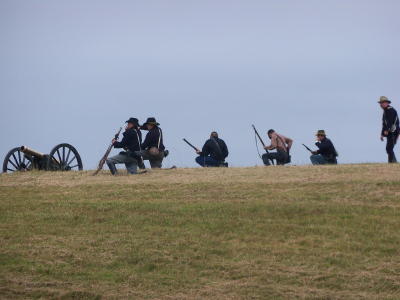
The battle expands to the hills and
hollows around the McDonald cabin
The object was to arrest some of the best known and most active rangers, notably those belonging to the band under Captain George Downs. The Perry Conley contingent usually operated farther to the South in the West Fork country.
Early in the morning of the twenty-eighth the detachment swooped down upon the home of Patrick Rafferty, who lived on the river a few miles east of Grantsville, and took him into custody, then moving quickly to a neighboring house the troopers picked up Jackson Wright--both men well known as raiders and marauders.
Associates who lived in the neighborhood took to the hills; Simpson knew that it would be futile and perhaps fatal to go into the woods to flush them out. He turned to the south to pay a visit to Arnoldsburg, the county seat and the secessionist center.
At just about the noon hour the detachment reached the home of Colonel Adonijah McDonald, late commanding officer of the county's 186th Regiment, Virginia Enrolled Militia, who lived on the divide between the forks of Sycamore, near a log building which served the community in the dual purpose of church and schoolhouse.
The hospitable colonel invited Simpson and his men to dine with him, but as the captain was somewhat pressed for time he accepted only for himself and five of his men.
The others were told to go to the homes of nearby residents for their noon meal, scattering out so that no one would he seriously inconvenienced or time lost in mass cooking.
Captain Conley had been alerted that the Federals were on the prowl and had hastily mustered his band, drawing on the men of other Moccasin groups.
He got together a force estimated at from forty to seventy-five--but probably not more than twenty-five--and moved out to capture or scatter the invading Union troopers.
By chance the two forces arrived in the region of the McDonald home at about the same time. Conley kept his men concealed in the dense woods nearby, and when the men started to scatter out it was a situation made to his order. But when his men moved forward they were detected by three Company C men who were on their way to a home nearby.
Hurrying back to the McDonald home to give the alarm, Simpson was given a few minutes to prepare for defense. Conley moved in close enough to make a demand for surrender, which was refused. The rangers opened fire on the house, pouring in volley after volley, which was returned by the defenders.
Then, finding the quarters too limited for action, Simpson moved his men into the yard, joined in a few minutes by others of the detachment who had been recalled by the sound of gunfire.
Other Simpson men took position in the church-schoolhouse, but too far away to be of any effective use in the firefight. After some forty-five minutes of brisk firing, using up most of the available ammunition, Conley signaled his men to withdraw.
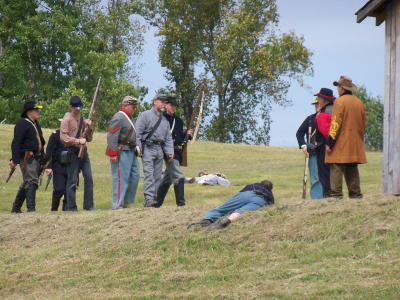
Rebs are caputured after battle, walking over dead soldiers
Not much damage had been done despite the tremendous waste of gunpowder. Private Sutton Cox, of Company C, had been shot through the leg and seriously disabled, and a few other men had received minor wounds and bruises.
On the Moccasin Ranger side there is no accurate account of the killed and wounded. The exaggerated report of the Intelligencer man said Conley withdrew "leaving four dead on the ground and carrying off two dead and all their wounded."
According to the men who were there, no dead were left on the ground. Some thought, however, that a couple or three dead men were carried away.
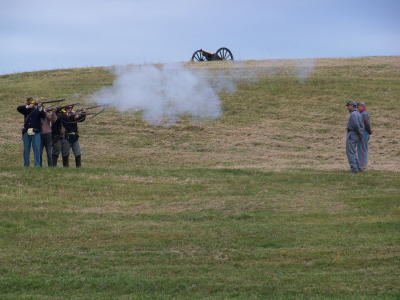
Union soliders, according to some accounts,
execute Reb soldiers after battle was over
Certainly, one of the rangers was killed, and his death did no credit to the men of Company C. The man, whose name has been lost, had been so severely wounded that he was unable to join his fellows on their retreat.
He had propped himself up against a rail fence where he was found by the Federals. Instead of rendering the aid that humanity dictates, even to an enemy on the battlefield, four or five of the men leveled their guns and fired on him, killing him instantly, an incident that could not but enrage the partisans and spur them on to like atrocities.
As booty, Captain Simpson collected several guns of nondescript character, running from squirrel rifles to heavy caliber flintlock muskets.
On taking a hasty departure, dinnerless, it was found that Private Cox was too badly injured to travel, and he was left at the McDonald home. Cox well knew that he would suffer the same fate as the ranger if found by any of Conley's company.
Painfully he dragged himself into the woods to find a hiding place, and that night he made his way to the home of a widow, Mrs. Mary Burrows--usually called "Granny"--who lived near the mouth of Steer Creek.
The kind old lady dressed his wounds and cared for him about two weeks, keeping him concealed in a cliff where shallow shelter was afforded, and denying to ranger scouts that she knew anything about him.
Fearing that Cox would eventually fall into the hands of the rangers, she appealed to a neighbor, James W. Johnson, for help to get him to safety at some Federal post.
"Uncle Jimmy" was at heart a Southern sympathizer, but withal a just and humane man. He abhorred bloodshed, and agreed to risk his own personal safety and that of his property by rendering aid to a wounded Union soldier so badly wanted by the Moccasin Rangers.
"Uncle Jimmy" pondered on ways and methods, and finally decided to move openly in a resort to stratagem. Early one morning he saddled his two horses, placing a sidesaddle on one, and rode to the home of Mrs. Burrows.
Cox was clad in one of "Granny's" dresses, her old poke bonnet was placed on his head with her big, steel-bowed spectacles on his eyes, mounted the sidesaddle and with his escort started down the river. All went well until within a few miles above Grantsville when they came face to face with Robert Wilson, who was directing a squad of ranger scouts.
The two were stopped and Wilson began making inquiries. With rare presence of mind "Uncle Jimmy" turned to Cox and said: "You ride on, Granny, for Betsy's powerful poorly; she's a mighty sick woman," indicating that his wife was sick and he had gone for help.
Cox rode on and Mr. Johnson joined him in a few minutes and together they worked on through to the Johnson home where Cox was given into the care of a Union neighbor. A few days later he was piloted through to Harrisville where, after a period of convalescence, he rejoined his company.
Cox fully recovered from his wound and went through the vicissitudes of nearly four years of war with Company C, and was in line of battle at Appomattox Court House on April 9, 1865, when General Lee surrendered. The company and regiment had undergone many changes; Captain Simpson had been promoted to major, but at the surrender the regiment was commanded by Major Michael A. Ayers, one of the original Company C recruits.
Rafferty and Wright were sent to Camp Chase, Columbus, Ohio, for a long sojourn as prisoners of war, and Captain Conley, whose name was a terror throughout the central counties, was killed in a fight with Federal troops in Webster County in the summer of 1862.
